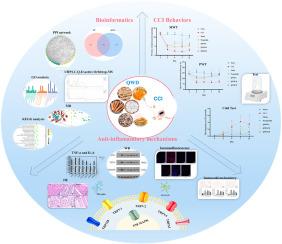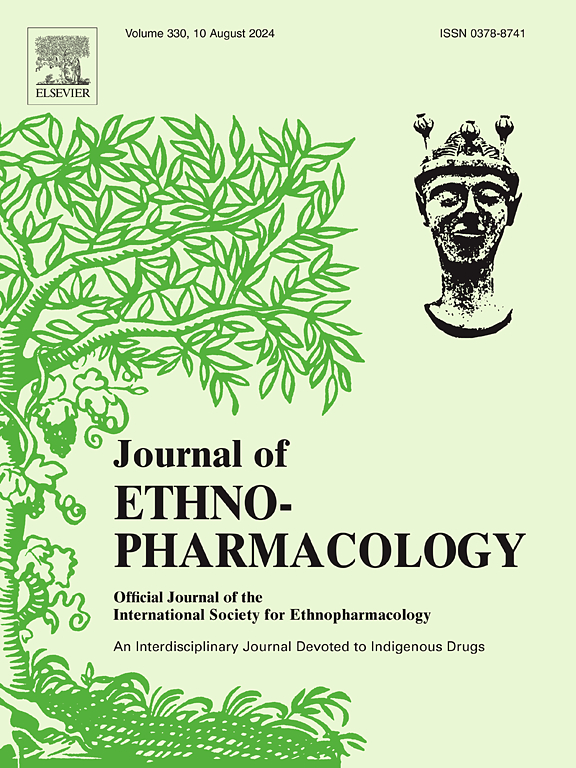芪生丸煎剂可通过 TRP 通道缓解 CCI 大鼠的炎症。
IF 4.8
2区 医学
Q1 CHEMISTRY, MEDICINAL
引用次数: 0
摘要
民族药理学意义:芪生丸(QWD)是一种传统中药,对神经病理性疼痛(NP)具有潜在的抗炎作用。然而,其有效成分和具体的抗炎机制仍不清楚:本研究旨在通过液相色谱法与网络药理学相结合的方法,确定瞿麦冬抗炎作用的有效成分,并通过慢性收缩性损伤(CCI)模型大鼠探讨其抗炎机制:采用 UHPLC-Q Exactive Orbitrap-MS 技术鉴定 QWD 的有效成分。通过网络药理学、分子对接和分子动力学模拟研究了QWD中针对治疗NP途径的潜在成分。在 CCI 大鼠诱导的 NP 模型操作后,给大鼠服用 QWD(5.6 克/千克/天、11.2 克/千克/天、22.4 克/千克/天)和普瑞巴林(10 克/千克/天)作为阳性对照,共 7 天。分别在 0、1、3、5、7、12 天对不同组大鼠的行为进行测试。并通过 ELISA 检测肿瘤坏死因子-α(TNF-α)和白细胞介素-6(IL-6)等炎症因子。同时,通过苏木精-伊红染色评估坐骨神经的炎症情况。免疫组化法检测了电离钙结合适配体分子-1(Iba-1)和神经胶质纤维酸性蛋白(GFAP)。此外,还通过 RT-PCR、Western 印迹和免疫组化检测了 TRPA1、TRPV1、TRPV2、TRPV3、TRPV4、TRPM8 和 P38 丝裂原活化蛋白激酶(MAPK)的表达:结果:通过液相色谱法和网络药理学方法筛选,确定了七十种 QWD 成分,并确定了七个核心靶点,包括癌基因酪氨酸蛋白激酶(SRC)、丝裂原活化蛋白激酶 3(MAPK3)、转录信号转导子和激活子 1(STAT1)、丝氨酸苏氨酸蛋白激酶 1(AKT1)、丝裂原活化蛋白激酶 1(MAPK1)、TNF-α 和 IL-6。六种活性成分的结合能小于-5 kcal/mol,复合物在 50 ns 内结构稳定。通路分析表明,瞬时受体电位(TRP)通道主要负责抗炎介质的调节。行为测试表明,与CCI组相比,QWD-L、QWD-M和QWD-H组能减轻机械痛、热痛和冷痛(结论:QWD-L、QWD-M和QWD-H组能减轻机械痛、热痛和冷痛):本研究对 QWD 在 CCI 模型大鼠中的抗炎作用成分及其分子机制进行了初步研究。QWD 的疗效是通过减少炎症反应实现的。QWD 还能抑制 TNF-α 和 IL-6 的水平,降低神经胶质中 Iba-1 和 GFAP 的活化。而这种抗炎机制涉及抑制 TRPA1、TRPV1、TRPV2、TRPV4 和 TRPM8 以及 p38 MAPK 信号通路。这些发现为使用 QWD 预防和治疗 NP 提供了科学和理论依据。本文章由计算机程序翻译,如有差异,请以英文原文为准。

Qisheng wan decoction alleviates the inflammation of CCI rats via TRP channels
Ethnopharmacological relevance
Qisheng wan decoction (QWD), a traditional Chinese medicine, has promising potential anti-inflammatory effects against neuropathic pain (NP). However, its valid ingredients and specific anti-inflammatory mechanisms are still unclear.
Aim of the study
This study aimed to identify the active ingredients of QWD responsible for its anti-inflammatory effect by combining liquid chromatography with network pharmacology, and to explore its anti-inflammatory mechanism by chronic constriction injury (CCI) model rats.
Materials and methods
The UHPLC-Q Exactive Orbitrap-MS technique was used to identify the active ingredients of QWD. The potential ingredients of QWD, which targeted to the pathways of treating NP, were performed by network pharmacology, molecular docking and molecular dynamics simulations. After CCI rats-induced NP model operation, QWD (5.6 g/kg/d, 11.2 g/kg/d, 22.4 g/kg/d) and Pregabalin (10 g/kg/d) as positive controls, were administered to the rats for 7 days. The behaviors of the different groups were tested at 0, 1, 3, 5, 7, 12 days, respectively. And the inflammatory factor including tumor necrosis factor-α (TNF-α) and interleukin-6 (IL-6) was detected by ELISA. Meantime, the inflammation of the sciatic nerve was evaluated by the hematoxylin-eosin staining. Ionized calcium-binding adapter molecule-1 (Iba-1) and glial fibrillary acidic protein (GFAP) were detected by immunohistochemistry. Moreover, the expressions of TRPA1, TRPV1, TRPV2, TRPV3, TRPV4, TRPM8, and P38 mitogen-activated protein kinase (MAPK) were tested by RT-PCR, Western blot, and immunohistochemistry.
Results
After screening by the liquid chromatography and network pharmacology approach, seventy ingredients of QWD were identified, and seven core targets including oncogene tyrosine-protein kinase (SRC), mitogen-activated protein kinase 3 (MAPK3), signal transducer and activator of transcription 1 (STAT1), protein-serine-threonine kinase 1 (AKT1), mitogen-activated protein kinase 1 (MAPK1), TNF-α, and IL-6 were confirmed. Six active ingredients exhibited binding energies less than −5 kcal/mol, and the complexes were structurally stable within 50 ns. Pathway analysis indicated that transient receptor potential (TRP) channels were mainly responsible for anti-inflammatory mediator regulation. Compared with the CCI group, the behavioral tests showed that QWD-L, QWD-M, and QWD-H group alleviated mechanical, thermal and cold hyperalgesia (p < 0.05). HE staining results found out QWD-L, QWD-M, and QWD-H group decreased the inflammation of the sciatic nerve (p < 0.05). Similarly, compared with the CCI group, the serum level of TNF-α and IL-6 of QWD groups decreased conformably (p < 0.05). This reduction was downtrend with the inhibition of Iba-1, GFAP, and the TRP channel signaling pathway and p38 MAPK.
Conclusions
This study provides a primary investigation of the composition of QWD for its anti-inflammation effect and its molecular mechanism in CCI model rats. And this therapeutic efficacy of QWD was achieved by decreasing the inflammation. QWD also inhibited the level TNF-α and IL-6 and decreasing the activation of Iba-1 and GFAP in glia. And this anti-inflammation mechanism involved in inhibiting the TRPA1, TRPV1, TRPV2, TRPV4, and TRPM8 and p38 MAPK signaling pathways. These findings provide a scientific and theoretical basis for the prevention and treatment of NP with QWD.
求助全文
通过发布文献求助,成功后即可免费获取论文全文。
去求助
来源期刊

Journal of ethnopharmacology
医学-全科医学与补充医学
CiteScore
10.30
自引率
5.60%
发文量
967
审稿时长
77 days
期刊介绍:
The Journal of Ethnopharmacology is dedicated to the exchange of information and understandings about people''s use of plants, fungi, animals, microorganisms and minerals and their biological and pharmacological effects based on the principles established through international conventions. Early people confronted with illness and disease, discovered a wealth of useful therapeutic agents in the plant and animal kingdoms. The empirical knowledge of these medicinal substances and their toxic potential was passed on by oral tradition and sometimes recorded in herbals and other texts on materia medica. Many valuable drugs of today (e.g., atropine, ephedrine, tubocurarine, digoxin, reserpine) came into use through the study of indigenous remedies. Chemists continue to use plant-derived drugs (e.g., morphine, taxol, physostigmine, quinidine, emetine) as prototypes in their attempts to develop more effective and less toxic medicinals.
 求助内容:
求助内容: 应助结果提醒方式:
应助结果提醒方式:


